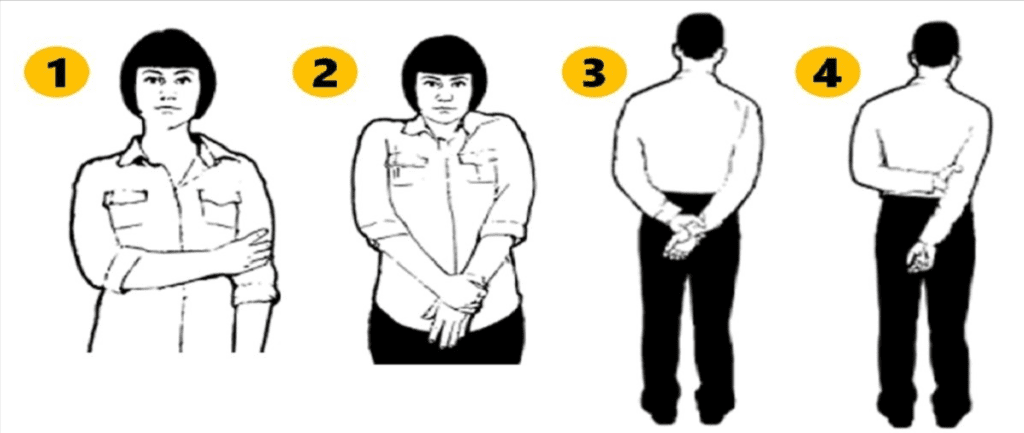Did you know the way you cross your arms can reveal a lot about your personality? From confidence to nervousness, your body language speaks louder than words. Crossing your arms isn’t just a random habit—it’s a window into your inner world.
Understanding Arms Crossing and Body Language

Body language is a powerful tool for communication. The way we sit, stand, walk, or even cross our arms can tell others what we’re feeling without saying a single word. Psychologists and body language experts agree that these small actions can reveal our confidence levels, emotional state, and even our social tendencies. Crossing your arms, in particular, is a gesture that holds many layers of meaning depending on the style.
While most people think crossed arms are a defensive move, the reality is more complex. Some arm-crossing styles exude authority and confidence, while others reveal insecurity or nervousness. Let’s break down the different ways of crossing arms and what each one says about you.
1. One Arm Crossed in Front: A Shield of Insecurity
If you cross one arm in front of your body, it’s often a sign of defensiveness or discomfort. This gesture acts as a subconscious shield, suggesting that you’re trying to protect yourself from external judgment. People who make this move might feel inadequate or shy, especially in social settings.
For example, imagine being at a crowded party. If someone crosses one arm while smiling, they might appear confident at first glance. However, their arm position tells a different story—it’s a silent plea for comfort and security. This gesture often signals stress, anxiety, or social awkwardness. It’s a common pose for introverts or those who feel out of place in a group.
2. Both Hands Clasped in Front: A Subtle Sign of Nervousness
Crossing both hands in front of your body, particularly over your abdomen, reveals vulnerability. This posture is a classic self-soothing technique used by individuals who feel exposed or uneasy. It’s often seen in situations where someone feels the need to appear calm but struggles internally.
Think of a speaker at a formal event who clasps both hands in front while addressing the audience. They might be putting on a brave face, but their body language suggests nervousness and a lack of confidence. This pose also signals self-restraint—an effort to keep emotions in check while feeling tense or out of place.
If you want to project confidence, it’s best to avoid this gesture. Instead, consider adopting a more open stance that exudes authority and assurance.
3. Both Hands Clasped Behind the Back: Confidence in Motion

When someone clasps both hands behind their back, it’s a clear display of confidence and pride. This open posture leaves the body exposed, signaling relaxation and a lack of fear. It’s the mark of someone who is comfortable in their own skin and demands respect without saying a word.
This gesture is common among authority figures such as CEOs, teachers, or police officers. It conveys power, control, and self-assurance. However, in hierarchical settings, someone lower on the chain might use this gesture to mask frustration or resentment toward authority figures.
For leaders and confident individuals, this pose is a natural way of asserting dominance and composure. It’s an effective stance to project power while maintaining calmness.
4. One Arm Clasped Behind the Back: Searching for Comfort

Clasping one arm behind your back can signal insecurity or submissiveness. This posture often indicates that someone is feeling small, powerless, or nervous. The tighter the grip on the arm, the stronger these emotions are.
This gesture is particularly common among teenagers, children, or individuals who feel uncertain in a situation. For example, a nervous student standing in front of a teacher might unconsciously clasp one arm behind their back, seeking comfort and reassurance. It’s a subtle cry for support, revealing a need for security and calm.
To counteract this impression, try transitioning to a more open stance, such as the palm-to-palm behind-the-back position. This adjustment can help you appear more confident and in control.
Crossed Arms Across the Chest: Commanding Yet Closed Off
The classic crossed-arms pose across the chest is often misinterpreted as purely defensive. While it can signal discomfort or resistance, it also depends on the context. In some cases, this posture conveys confidence, authority, and assertiveness.
For example, a boss addressing their team with arms crossed might seem commanding and focused. However, in a heated argument, the same gesture could signal defiance or unwillingness to engage. It’s a versatile pose that reflects a mix of emotions based on the situation.
If you want to appear approachable, consider relaxing your stance and allowing your arms to fall naturally by your sides. This adjustment can make you seem more open and willing to engage with others.
The Science Behind Arms Crossing

Why do these arm-crossing styles reveal so much about our personalities? The answer lies in the subconscious. Our bodies often mirror our emotions and thoughts, even when we’re not aware of it. Crossing your arms is a way of creating physical boundaries, signaling everything from vulnerability to dominance.
Cultural factors also play a role. In some cultures, crossing arms is a sign of respect or attentiveness, while in others, it might be seen as rude or dismissive. Context matters, so it’s essential to consider the situation before drawing conclusions about someone’s personality based on their arm posture.
Conclusion: A Window to Your Inner World
The way you cross your arms isn’t just a random habit—it’s a reflection of your inner emotions, confidence levels, and personality traits. From the defensive one-arm cross to the commanding hands-behind-the-back stance, these subtle gestures speak volumes about who you are.
So, the next time you cross your arms, take a moment to think about what your body language might be saying. Are you feeling confident, nervous, or somewhere in between? Understanding these cues can help you project the image you want and interpret the signals others are sending.
Body language is a fascinating way to connect with others and gain insights into human behavior. By mastering your own gestures, you can navigate social situations with greater ease and confidence. After all, your arms are saying more than you think—make sure they’re telling the right story!


